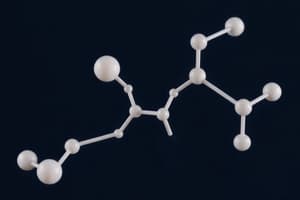Podcast
Questions and Answers
Which feature is most commonly associated with digital scanning apps like CamScanner?
Which feature is most commonly associated with digital scanning apps like CamScanner?
- Inbuilt cardboard detection
- Ability to scan documents using a regular camera (correct)
- Increased paper consumption
- Limited sharing options
What is a significant use case for CamScanner?
What is a significant use case for CamScanner?
- Developing software applications
- Playing multimedia files
- Digitally archiving printed documents (correct)
- Creating high-resolution graphic designs
Which of the following best explains the potential downside of using scanning apps?
Which of the following best explains the potential downside of using scanning apps?
- They can lead to over-reliance on digital storage solutions (correct)
- They only allow scanning in black and white
- They can only be used on specific operating systems
- They require additional hardware to function
What might users need to be cautious about when using CamScanner?
What might users need to be cautious about when using CamScanner?
Which characteristic is LEAST important when choosing a scanning app like CamScanner?
Which characteristic is LEAST important when choosing a scanning app like CamScanner?
Flashcards
CamScanner
CamScanner
A mobile application for scanning documents.
Mobile document scanner
Mobile document scanner
An app that scans and digitizes documents.
Document Digitization
Document Digitization
Converting physical documents into digital format.
Mobile Application
Mobile Application
Signup and view all the flashcards
Scanning
Scanning
Signup and view all the flashcards
Study Notes
Patient Case Study
- A 40-year-old male presented at the emergency department
- Complaints: increased thirst, hunger, frequent urination, weight gain (past year)
- Examination: fasting blood glucose level of 135 mg/dL
Carbohydrate Classification
- Carbohydrates are classified into four main groups:
- Monosaccharides
- Disaccharides
- Oligosaccharides
- Polysaccharides
Monosaccharides
- Simplest form of carbohydrates
- Cannot be hydrolyzed into simpler carbohydrates
- Examples: Glucose, Fructose, Ribose, Galactose
Glucose
- Also known as "blood sugar"
- Immediate energy source
- Glycogen is its storage form
Fructose
- Sweetest sugar
- Naturally found in fruits and honey
- Also known as "fruit sugar"
Galactose
- Present in milk
- Needed for various biomolecules
- Crucial for brain and nervous tissue development in infants
Monosaccharide Importance
- Fructose: abundant in seminal fluid, a crucial energy source for sperm
- Galactose: vital for synthesizing various biomolecules, important for infant brain and nervous system development
Monosaccharide Classification (Families)
- Aldoses (aldehyde group)
- Ketoses (ketone group)
Monosaccharide Classification (Number of Carbons)
- Triose (3 carbons)
- Tetrose (4 carbons)
- Pentose (5 carbons)
- Hexose (6 carbons)
- Heptose (7 carbons)
Examples of Aldoses and Ketoses
- Aldoses: Glyceraldehyde, Erythrose, Ribose, Glucose
- Ketoses: Dihydroxyacetone, Erythrulose, Ribulose, Fructose
Stereoisomerism
- Isomers: same chemical formula, different chemical structure
- Stereoisomers: same molecular formula, same functional groups, but different spatial arrangements
- Conformational isomers: different arrangements of atoms within a molecule due to rotation around single bonds
Chiral Carbon
- Carbon atom bonded to four different groups
- Important in determining isomerism
- All monosaccharides have chiral carbon atoms, except dihydroxyacetone
D & L Isomers
- Nonsuperimposable mirror images of each other
- D-sugars predominantly found in nature
- Example: D-Ribose, D-Glucose
Enantiomer Properties
- Rotate plane-polarized light equally but in opposite directions
- Levorotatory (-)
- Dextrorotatory (+)
- Optically active molecules exhibit this property
How Many Chiral Carbons?
- Determine the number of chiral carbon atoms
Epimers
- Diastereomers that differ in configuration around only one chiral carbon
Cyclization of Glucose and Fructose
- Cyclization forms cyclic structures (α and β anomers)
- Alpha (OH below the ring)
- Beta (OH above the ring)
Reducing Sugars
- Can act as reducing agents
- Free aldehyde (C1) or ketone (C2) group
Mutarotation
- Spontaneous interconversion of cyclic α and β anomers in solution
- Equilibrium between α and β forms
Terminologies
- Enantiomers: nonsuperimposable mirror images
- Epimers: differ only in configuration around one chiral carbon
- Anomers: differ in configuration at the anomeric carbon
Diabetes
- Symptoms: Increased thirst, frequent urination, extreme hunger, etc
- Normal fasting blood sugar: <100 mg/dL
- Prediabetes: 100-125 mg/dL
- Diabetes: ≥126 mg/dL (on two separate tests)
- Type 1 DM: pancreas fails to produce enough insulin
- Type 2 DM: cells fail to respond to insulin properly
Studying That Suits You
Use AI to generate personalized quizzes and flashcards to suit your learning preferences.
Related Documents
Description
This quiz explores the classification of carbohydrates focusing on monosaccharides, while also examining a clinical case study of a patient presenting symptoms related to glucose levels. Understand the significance of carbohydrate types and their roles in human health, especially in diabetes management.




